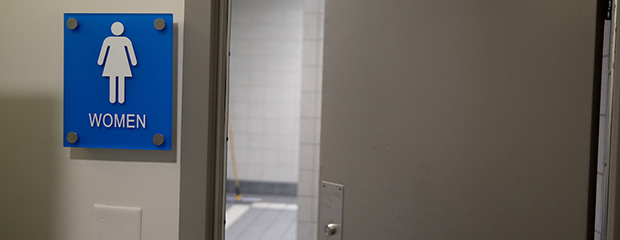The Battle Over Bathrooms Is Far From Over
A high school boy is standing in his underwear about to put on his gym clothes when he notices a female student, also in a state of undress, is in the boy’s locker room. When bringing it to the attention of school officials he’s told he must treat changing clothes alongside students of the opposite sex as “natural” as possible.
Parents are shocked to learn in media reports that boys are now allowed in the girls’ locker rooms in their neighborhood schools. All a boy has to do, they learned, is to self-identify as female for total access. Parents are demanding to be heard by school administrators, yet find it hard even to receive prior notice from the school or be granted access to public documents to understand how these rules were drafted in the first place.
With a growing list of scenarios like these, it should come as no surprise that Texans would defend common sense in the halls of the Legislature via the Texas Privacy Act. Despite this, the Legislature failed to set a statewide standard on what once used to be an unwritten rule: that men use men’s restrooms and women use women’s restrooms. And it failed even with a free-market proviso that the rule only applies to public schools and other government facilities.
Opponents balked at the notion, accusing supporters of creating a problem that did not exist before and framing the issue as an “anti-transgender bathroom bill.” Texas House leaders Speaker Joe Straus and Chairman Byron Cook blocked fellow Republicans from debating the bill in the full House, calling it a distraction. In truth, this is an issue that has been building for a long time, often intentionally out of the view of taxpayers, becoming by far the most recognizable and commented-on bill of the recent legislative session.
This so-called “bathroom war” has its roots in various and largely unsuccessful attempts over the last decade to add sexual orientation and gender identity (or SOGI) classifications to state and federal statutes and administrative law.
Even just five years ago, there weren’t many Texans — seasoned political observers included — who realized the consequences of these rule changes. In 2012, Texas Values became the subject of a PolitiFact investigation, practically calling us liars for our suggestion that SOGI laws would culminate with a statewide fight over who goes into which restroom or shower. Now everyone knows what we knew all along: Yes, it’s about bathrooms.
Take into consideration Houston’s Equal Rights Ordinance, or HERO, that applied, in part, to bathrooms and which Houston voters rejected 61-39 percent in November 2015 when a court allowed the matter to be taken to polls. In 2016, the Obama administration issued a “Dear Colleague” letter to educators (later rescinded by the Trump Administration) opening the doors of public school restrooms to students based on their gender identities.
This issue has been actively litigated. Texas Attorney General Ken Paxton, joined a 13-state coalition that successfully asked a federal district court to block enforcement of Obama’s guidelines in 2016. Earlier this year, the U.S. Supreme Court declined to hear a restroom access case in which a Virginia school board moved to prevent student Gavin Grimm, born a female, from using the boys’ bathroom.
Most recently, San Antonio ISD (on Aug. 28) approved a rule adding sexual orientation and gender identity and expression to the school “discrimination” policy, which applies to bathrooms, showers and locker rooms. (Yes, it’s about bathrooms, too.) Again, this was passed following a cryptically worded public notice and virtually no community input — as was the case in earlier instances in the Dripping Springs, Fort Worth and Coppell ISDs.
The Texas Privacy Act proposed in the 85th Legislature attempted to create a single, statewide standard for public school and government buildings, gaining the support of a majority of the Texas Senate, the Texas House, and Gov. Greg Abbott.
Opponents tried to insinuate that the entire premise of a “bathroom bill” was ridiculous. In addition to the undeserved mockery, the critical response has attempted to label the Texas Privacy Act as merely an attempt to regulate bathroom use or, worse, as an “anti-transgender bathroom bill.” It should be noted that this law was not drafted as a means to stop an imagined groundswell of transgender sexual predators; rather, the bill was designed to prevent would-be predators from using the concept of “gender identity” as cover.
Some opponents of the Privacy Act accused supporters of a laughable premise of their own: the establishment of “bathroom police” to verify the sex of those entering the facilities. But as the sponsor, Sen. Lois Kolkhorst, R-Brenham, noted, the legislation was intended as a “remedy” for those whose privacy had already been violated.
Some criticized our verbiage of “keeping men out of little girls’ showers, restrooms, and changing areas.” Yet the great number of sexual assault and privacy violation cases are males approaching females. The bill found favor with a growing number of feminists who still believe in establishing “safe spaces” in our public buildings.
The bill may be dead, but the struggle is far from over. The battle will now be fought from school district to school district, from city to city, and from county to county, costing the taxpayers untold amounts in staff time in legal fees and potential settlements. The “bright” side of this is that as these local gender identity and gender expression policies are implemented, we can more accurately track the privacy violation incidents that will unfortunately occur.
We were right about what SOGI policies would lead to. And we will be proven right again when the need for a single, statewide standard becomes increasingly clear and the public outcry becomes louder long before the 86th Legislature convenes in 2019.
*This article originally appeared on TribTalk, a publication of the Texas Tribune.


